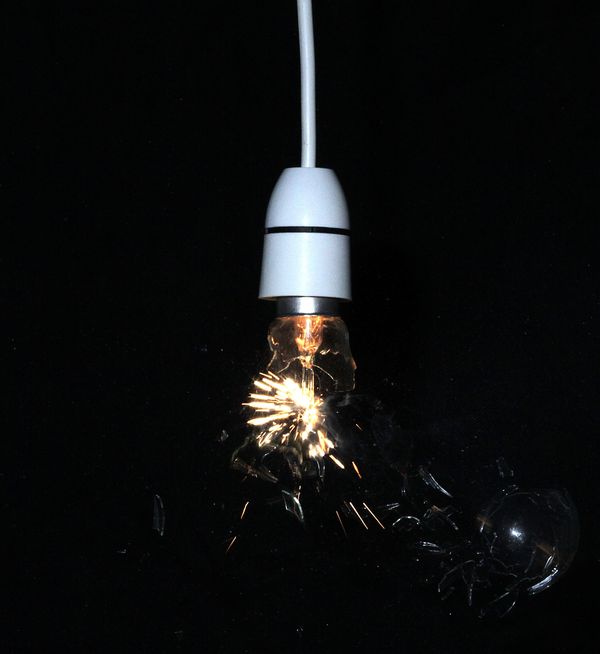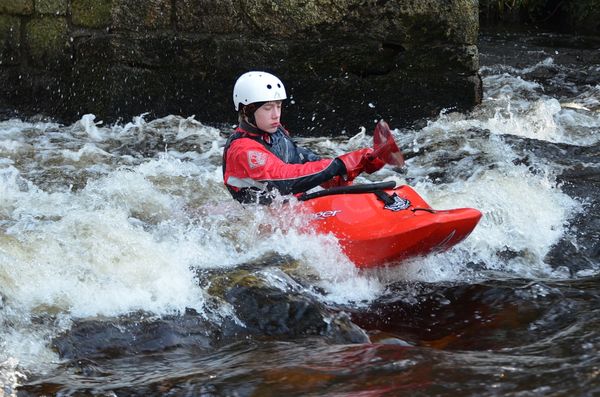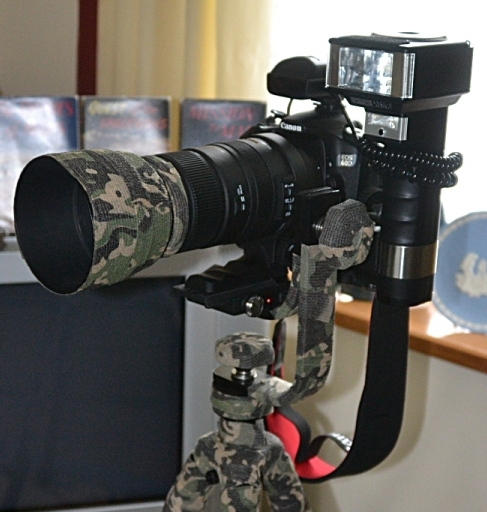Flash Guide Numbers
Feb 1, 2013 06:47:54 #
I know now that an external flash is more powerful than a built in flash. But now I am confused, I decided to try to compare the power of two different external flash units. The first, a Sunpac PZ42x says its guide number is 112' (34.14 m) ISO100 at 50 mm position , compared to the Nikon Sb600 flash which says ISO 100, zoom head at 35mm ; 30m (98ft) or 30/98 (ISO 100, m/ft)
42/138 (ISO 200, m/ft). I have spent an hour or more googling definitions, specs, reviews, and still am confused if one is more powerful than the other. My sense of the different info is that as far as maximum brightness they are similar, but every spec I see has different standards of measurement it seems, different "mm's" different zooms, etc.
42/138 (ISO 200, m/ft). I have spent an hour or more googling definitions, specs, reviews, and still am confused if one is more powerful than the other. My sense of the different info is that as far as maximum brightness they are similar, but every spec I see has different standards of measurement it seems, different "mm's" different zooms, etc.
Feb 1, 2013 07:16:03 #
Right, forget it.
http://www.naturephotographers.net/articles0703/jm0703-1.html
The VERY best site is THIS for canon users
http://photonotes.org/articles/eos-flash/index.html
I use may guns depending on what I want to do and in fact have a PZ42X and it is a superb gun, Sunpak have been around for 40 years and I still have a 30 year old perfect AZ4000.
WHAT do YOU want it for.
The setup/gun for this shot will be totally different for another sort of shot
http://i928.photobucket.com/albums/ad121/jser1/Img_7676edited-1.jpg
http://i928.photobucket.com/albums/ad121/jser1/baloon2-1.jpg
http://i928.photobucket.com/albums/ad121/jser1/Image2-8.jpg
Where as for This canoe I used the one below (off tripod)
http://www.naturephotographers.net/articles0703/jm0703-1.html
The VERY best site is THIS for canon users
http://photonotes.org/articles/eos-flash/index.html
I use may guns depending on what I want to do and in fact have a PZ42X and it is a superb gun, Sunpak have been around for 40 years and I still have a 30 year old perfect AZ4000.
WHAT do YOU want it for.
The setup/gun for this shot will be totally different for another sort of shot
http://i928.photobucket.com/albums/ad121/jser1/Img_7676edited-1.jpg
http://i928.photobucket.com/albums/ad121/jser1/baloon2-1.jpg
http://i928.photobucket.com/albums/ad121/jser1/Image2-8.jpg
Where as for This canoe I used the one below (off tripod)



Feb 1, 2013 15:03:58 #
Nice shots, I would like to try effects like that! I did a series of ocean waves where I froze the motion at a high shutter speed to capture those little globuals of water. Right now I was trying to take family photos indoors, and I seemed to reach the limits of the flash's power and shutter speeds possible. I will try to post some later. It was a balancing act, the flash strength, the aperture, the shutter speeds, but a lot came out dark, especially the backgrounds, even though they look good on the camera screen, they looked darker on the computer and had to be fixed. I was wondering if my flash(Sunpak PZ42X)power was weak compared to the Nikon SB600 for instance, but I could not find compatible guide numbers, different sites (I couldn't find one site that reviewed both with the same system of measurement, ie. @50mm, @100mm, feet, etc.)used different ways of stating it that confused me. The info seems to say they may be similar in strength, compared to the built in camera flash. But some indicated the SB600 was stronger, others the PZ42X, depending on how you interpret the numbers.
JR1 wrote:
Right, forget it. br br http://www.naturephotogra... (show quote)
Feb 1, 2013 15:11:57 #
I finally decided I just wanted to understand the guide number system, for intellectual purposes, and future use in rating flashes, but I couldn't get a handle on it. I read various sites like Wikipedia, etc. but no one really explained the terms used sufficiently. There always seems to be a level of "you already know what we mean' with various terms...like "@70mm, meaning it has a limit of 69 feet" then @100mm. Larger guide numbers mean more strength, but they seemed to increase with distance, instead of decreasing, Argh, my brain is starting to hurt!
Feb 1, 2013 15:29:07 #
The guide number is the reach of the flash in metres. The problem then comes with the flash with a zoom head which means it can have a narrower flash spread over that distance/or a weaker light. no idea which is better. I use manual flash as i'm a skinflint and won't pay for Canon till I master it.
Also remember that the flash lights for a millisecond and your apperture / speed /ISO affects the background exposure unless the background is where your focal point is... Play with a 'cheap manual one and and have fun...see yongnu on utube
Also remember that the flash lights for a millisecond and your apperture / speed /ISO affects the background exposure unless the background is where your focal point is... Play with a 'cheap manual one and and have fun...see yongnu on utube
Feb 1, 2013 15:53:45 #
Ok. Looks lilke your question hasn't been directly addressed so I'll take a stab at it:
1. Guide numbers in feet/meters have a mathematical relationship to the f stop you need to use on an average subject, based on the subject's distance from the flash.
Basically, divide the distance of the subject into the guide number to get the f stop. If the subject is 10 feet away and the guide number is 98 ft, then 98/10= 9.8 and that is the f stop you should use.
2. Some modern flash heads can zoom out and simulate the angle of view of a longer than standard focal length lens. For example, a 100mm lens has a narrower angle of view than a 50mm lens. Zooming the flash head concentrates the light into a smaller area and so you get a larger guide number. The idea is to pair the zoom factor with the focal length of the lens you are using and use the resulting guide number in your calculation.
This is really all you need to know to get started and make sense of the system. Yep, there is more, but you aren't likely to need it unless you get into very technical situations. Few photographers use the system now, because Through the Lens (TTL) flash control is all over the place.
Mostly we just use the guide numbers as an indication of the relative power of the units. If one is rated at 50mm and another at 35mm it isn't a great difference.
1. Guide numbers in feet/meters have a mathematical relationship to the f stop you need to use on an average subject, based on the subject's distance from the flash.
Basically, divide the distance of the subject into the guide number to get the f stop. If the subject is 10 feet away and the guide number is 98 ft, then 98/10= 9.8 and that is the f stop you should use.
2. Some modern flash heads can zoom out and simulate the angle of view of a longer than standard focal length lens. For example, a 100mm lens has a narrower angle of view than a 50mm lens. Zooming the flash head concentrates the light into a smaller area and so you get a larger guide number. The idea is to pair the zoom factor with the focal length of the lens you are using and use the resulting guide number in your calculation.
This is really all you need to know to get started and make sense of the system. Yep, there is more, but you aren't likely to need it unless you get into very technical situations. Few photographers use the system now, because Through the Lens (TTL) flash control is all over the place.
Mostly we just use the guide numbers as an indication of the relative power of the units. If one is rated at 50mm and another at 35mm it isn't a great difference.
Feb 1, 2013 15:56:39 #
In a prior life we tested each flash used to determine its specific guide number. Today it's easier because digital capture records the aperture used.
To determine your flash guide number find a location large enough to position your subject ten (10) feet from the flash with the camera mounted on a tripod. Take a series of exposures working from the largest aperture opening (lowest number) through the smallest aperture opening (largest number). Study each image and choose the one that you feel is the best. Look at the aperture used for that shot and multiply by 10 to arrive at the guide number. Example: f/8 = 8X10=80. The guide number for that specific flash would be 80.
The guide number relates to the ISO to the flash light output. Knowing the actual guide number means that you can divide the distance from flash to subject by the guide number to determine the aperture needed for the scene.
To determine your flash guide number find a location large enough to position your subject ten (10) feet from the flash with the camera mounted on a tripod. Take a series of exposures working from the largest aperture opening (lowest number) through the smallest aperture opening (largest number). Study each image and choose the one that you feel is the best. Look at the aperture used for that shot and multiply by 10 to arrive at the guide number. Example: f/8 = 8X10=80. The guide number for that specific flash would be 80.
The guide number relates to the ISO to the flash light output. Knowing the actual guide number means that you can divide the distance from flash to subject by the guide number to determine the aperture needed for the scene.
Feb 1, 2013 16:33:21 #
georgevedwards wrote:
I know now that an external flash is more powerful... (show quote)
Nikonian72 has posted a chart listing the GNs of various units in the macro section of UHH. I would suggest using the search function of UHH and then looking for that link.
Feb 1, 2013 17:50:21 #
Thanks for the info, that does clear it up a little more, although the TTL ddn't work well. Maybe I didn't understand, I think I have read that it only works in certain modes. I eventually went to manual and just made adjustments until it looked right. Thanks for the tip on the zoom flash, that was one feature that I didn't understand; so the flash actually makes a tight beam for longer focal length zoom lens settings.
photoninja1 wrote:
Ok. Looks lilke your question hasn't been directly... (show quote)
Feb 1, 2013 17:54:56 #
Sounds logical. One video tutorial I saw kept emphasing a triangular system based on shutter speed, aperture and flash strength. One tricky part was that it said the shutter speed only affected the background lighting, a slower speed would make the background lighter...?
ziggykor wrote:
In a prior life we tested each flash used to deter... (show quote)
Feb 1, 2013 17:59:38 #
One problem I had was with a wide angle group shot, I found the flash was center weighted in the preview screen, I fixed it by putting on the diffuser which helped spread the light out, but at that point it was just "try this and see what happens", trial by error I think it is called, but I always want to really understand something beforehand so I know how to control it at will.
G Brown wrote:
The guide number is the reach of the flash in metr... (show quote)
Feb 2, 2013 06:27:39 #
photoninja1 wrote:
Ok. Looks lilke your question hasn't been directly... (show quote)
Well done!
Gets to the heart of the matter without going round the houses asking why the OP wants to know, or answering questions that weren't asked.
Feb 2, 2013 07:21:35 #
I just would like to point out that if you are considering using an older flash be sure it is low voltage across the hot shoe (they almost never are). They will fry your digital camera's electronic. I use some older zoom flashes but wirelessly, off the shoe, but no TTL, of course (anyway). Even cables can ruin your camera.
And if so, always use a voltmeter yourself. So many of these companies have changed hands or marketed different manufactureres under their own names you cannot trust their specification literature.
And if so, always use a voltmeter yourself. So many of these companies have changed hands or marketed different manufactureres under their own names you cannot trust their specification literature.
Feb 2, 2013 08:09:13 #
Wabbit
Loc: Arizona Desert
georgevedwards wrote:
Thanks for the info, that does clear it up a littl... (show quote)
Hey Doc ..... your flash is targeted at your subject in focus, not necessarily what's behind ..... also keep in mind that even though your flash ready light may show ready your batteries could be week and / or the flash gun may not have charged up fully yet .....
..... the light from the gun doesn't flash, the light comes on then goes off in conjunction with your shutters ..... this happens so fast to the human eye it seems like a flash ..... When the batteries are on the week your lighting will be limited .....
..... here's decent basic flash info .....
http://www.scantips.com/lights/flashbasics.html
Feb 2, 2013 10:18:11 #
If you want to reply, then register here. Registration is free and your account is created instantly, so you can post right away.








